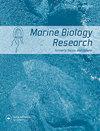Seasonal biomass and composition of mesozooplankton communities in Sea of Oman and Arabian Sea
IF 1.2
4区 生物学
Q4 ECOLOGY
引用次数: 0
Abstract
ABSTRACT Samples of mesozooplankton were collected and analysed from two contrasting coastal regions; Muscat (Sea of Oman) and Salalah (Arabian Sea). Copepods represented 41-44% of total biomass. Small species such as Temora turbinata, Oithona spp., Oncaea spp. and Microsetella spp. were abundant but their contribution to total biomass was small compared with the much rarer but larger species such as Eucalanidae, Calanoides natalis or Labidocera pavo. In Muscat, T. turbinata was particularly abundant, whereas C. natalis and Eucalanidae were more abundant in Salalah. Biomass in Muscat seems to be associated with a series of different species peaks showing no clear seasonality. However, biomass in Salalah followed a distinct seasonality with higher biomass during southwest monsoon., a seasonality pattern was observed with the meroplankton/holoplankton ratio in Salalah but not in Muscat. PERMANOVA analysis indicated that the communities structure showed geographic and seasonal differences. The effect of seasonality was particularly visible when the dataset included non-copepods, highlighting the role of this group in structuring mesozooplankton communities. Non-copepods such as chaetognaths and doliolids had a high biomass contribution to both geographic areas. normalized size spectra in both regions were similar and suggested that smaller species were underestimated Whereas, large species, especially chaetognaths, were over-represented.阿曼海和阿拉伯海中浮游动物群落的季节性生物量和组成
摘要从两个对比鲜明的沿海地区采集并分析了中型浮游动物的样本;马斯喀特(阿曼海)和萨拉拉(阿拉伯海)。桡足类占总生物量的41-44%。小物种如Temora turbinata、Oithona spp.、Oncaea spp.和Microsetella spp.数量丰富,但与更稀有但更大的物种如Eucalanidae、Calanoides natalis或Labidocera pavo相比,它们对总生物量的贡献很小。在马斯喀特,T.turbinata特别丰富,而C.natalis和Eucalanidae在萨拉拉更丰富。马斯喀特的生物量似乎与一系列不同物种的峰值有关,这些峰值没有明确的季节性。然而,萨拉拉的生物量具有明显的季节性,西南季风期间的生物量较高。,萨拉拉观察到单体浮游生物/全体浮游生物比例的季节性模式,但马斯喀特没有。PERMANOVA分析表明,群落结构存在地理和季节差异。当数据集包括非桡足类时,季节性的影响尤其明显,突出了这一群体在构建中型浮游动物群落中的作用。非桡足类动物,如毛颌类和多足类,对这两个地理区域都有很高的生物量贡献。两个区域的归一化大小谱相似,表明较小的物种被低估了,而较大的物种,尤其是毛颚,则被高估了。
本文章由计算机程序翻译,如有差异,请以英文原文为准。
求助全文
约1分钟内获得全文
求助全文
来源期刊

Marine Biology Research
生物-海洋与淡水生物学
CiteScore
2.10
自引率
0.00%
发文量
55
审稿时长
6-12 weeks
期刊介绍:
Marine Biology Research (MBRJ) provides a worldwide forum for key information, ideas and discussion on all areas of marine biology and biological oceanography. Founded in 2005 as a merger of two Scandinavian journals, Sarsia and Ophelia, MBRJ is based today at the Institute of Marine Research, Bergen, Norway. The Journal’s scope encompasses basic and applied research from all oceans and marine habitats and on all marine organisms, the main criterium for acceptance being quality.
 求助内容:
求助内容: 应助结果提醒方式:
应助结果提醒方式:


